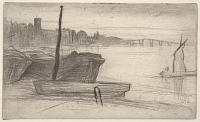Freetext search terms: mast
Chelsea Bridge and Church | ||
| Number: | 102 | |
| Date: | 1871 | |
| Medium: | etching and drypoint | |
| Size: | 103 x 170 mm | |
| Signed: | no | |
| Inscribed: | no | |
| Set/Publication: | 'Thames Set', 1871 | |
| No. of States: | 7 | |
| Known impressions: | 56 | |
| Catalogues: | K.95; M.96; T.53; W.85 | |
| Impressions taken from this plate (56) | ||
PUBLICATION
14: [F.G. Stephens], The Athenaeum, 26 August 1871, pp. 280-81.
EXHIBITIONS
 , and
, and  or possibly
or possibly  ). 15
). 15
It was shown at several print dealers' shows, by Craibe Angus in Glasgow in 1879, in New York by F. Keppel & Co. in 1902 and by H. Wunderlich & Co. in 1898 (
 ) and 1903, and in London by Obach & Co. in 1903. Charles Lang Freer (1856-1919) bought an impression from the 1898 show (
) and 1903, and in London by Obach & Co. in 1903. Charles Lang Freer (1856-1919) bought an impression from the 1898 show ( ). 16
). 16
An impression hung in an major exhibition in Leipzig in 1895. Another was shown in the exhibition organised by the Caxton Club in Chicago in 1900, lent by Bryan Lathrop (1844-1916) (
 ). 17
). 17
15: New York 1881 (cat. no. 119, 120). See REFERENCES : EXHIBITIONS.
16: New York 1898 (cat. no. 80).
17: Chicago 1900 (cat. no. 80).
18: New York 1904a (cat. no. 88); London Mem. 1905 (cat. no. 85).
SALES & COLLECTORS
 ). It was a third state, and had been taken from Whistler's stocks of earlier impressions, preceding the main print-run of the 'Thames Set' in the fifth and sixth states.
). It was a third state, and had been taken from Whistler's stocks of earlier impressions, preceding the main print-run of the 'Thames Set' in the fifth and sixth states.The British Museum bought a final state in 1874 (
 ); the Bibliothèque nationale de France bought two, one a cancelled impression, probably from Frederick Keppel (1845-1912) of F. Keppel & Co., in 1903 (
); the Bibliothèque nationale de France bought two, one a cancelled impression, probably from Frederick Keppel (1845-1912) of F. Keppel & Co., in 1903 ( ,
,  ); Henry F. Sewall (1816-1896) bought one for the Boston Museum of Fine Arts in 1897 (
); Henry F. Sewall (1816-1896) bought one for the Boston Museum of Fine Arts in 1897 ( ).
).19: Sotheby's, 3 March 1892 (lot 136).
20: Christie's, 14 March 1893 (lot 315).
 ). Freer bought a 'darkly printed' final state from F. Keppel & Co. in 1894 (
). Freer bought a 'darkly printed' final state from F. Keppel & Co. in 1894 ( ) and a lighter one from Thomas Way (1837-1915) in 1905 (
) and a lighter one from Thomas Way (1837-1915) in 1905 ( ); as well as an impression from the cancelled plate from Keppel in 1896 (
); as well as an impression from the cancelled plate from Keppel in 1896 ( ). Similarly, Samuel Putnam Avery (1822-1904) bought an early state (
). Similarly, Samuel Putnam Avery (1822-1904) bought an early state ( ), a later one with crayon additions (
), a later one with crayon additions ( ), and a final state (
), and a final state ( ).
). ); James Guthrie Orchar (1825-1888) (
); James Guthrie Orchar (1825-1888) ( ); George Aloysius Lucas (1824-1909) (
); George Aloysius Lucas (1824-1909) ( ); Bernard Buchanan MacGeorge (1845?-1924) and Howard Mansfield (1849-1938) (
); Bernard Buchanan MacGeorge (1845?-1924) and Howard Mansfield (1849-1938) ( ); Henry Studdy Theobald (1847-1934) (
); Henry Studdy Theobald (1847-1934) ( ); Constantine Alexander Ionides (1833-1900), who bequeathed one in 1901 to the V&A (
); Constantine Alexander Ionides (1833-1900), who bequeathed one in 1901 to the V&A ( ); Joseph Longworth, who gave an impression of the sixth state to Cincinnati Art Museum in 1883 (
); Joseph Longworth, who gave an impression of the sixth state to Cincinnati Art Museum in 1883 ( ); Bryan Lathrop (1844-1916) (
); Bryan Lathrop (1844-1916) ( ) and Charles Deering (1852-1927) (
) and Charles Deering (1852-1927) ( ), whose collections went to the Art Institute of Chicago; Henry Nazeby Harrington (1862-1937) (
), whose collections went to the Art Institute of Chicago; Henry Nazeby Harrington (1862-1937) ( ,
,  ); Harry Brisbane Dick (1855-1916) (
); Harry Brisbane Dick (1855-1916) ( ); and Pauline Kohlsaat Palmer (1882-1956) (
); and Pauline Kohlsaat Palmer (1882-1956) ( ). An impression acquired in 1893 by the Staatliche Graphische Sammlung, Munich, 1893 was destroyed in fire in 1944.
). An impression acquired in 1893 by the Staatliche Graphische Sammlung, Munich, 1893 was destroyed in fire in 1944.
